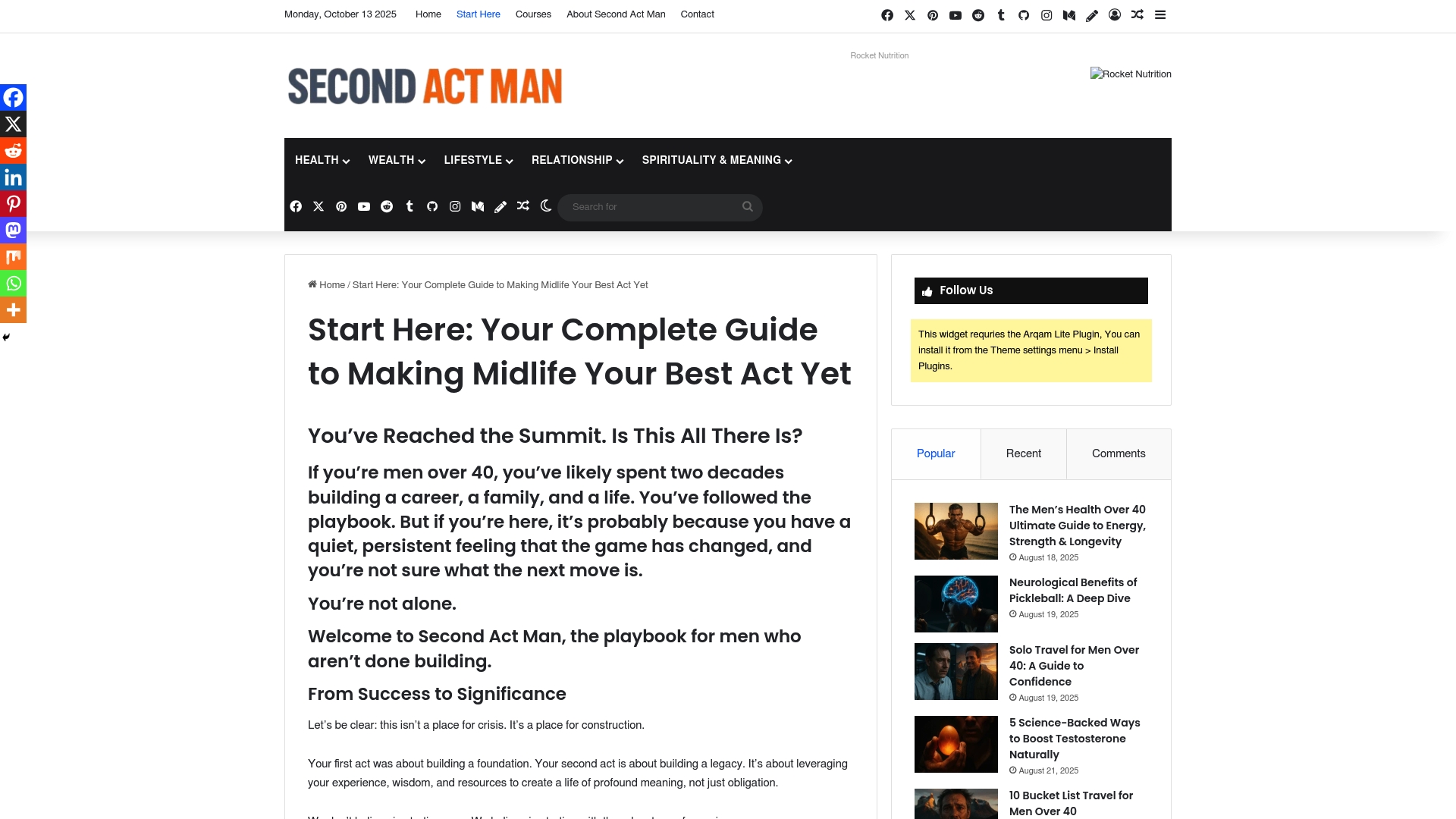Improving Work Performance After 40: Step-by-Step Guide

Did you know that only about 30 percent of professionals feel they reach their full potential at work? Many talented people struggle to grow because they lack a clear strategy for improvement. When you understand your strengths, set precise goals, and adapt new skills, you become more confident and competitive. A focused approach like this helps you map out a path that leads to lasting professional growth and greater success in any workplace.
Table of Contents
- Step 1: Assess Current Strengths and Weaknesses
- Step 2: Set Targeted Performance Goals
- Step 3: Upgrade Skills for Modern Work Demands
- Step 4: Implement Effective Productivity Techniques
- Step 5: Track Progress and Refine Your Approach
Quick Summary
| Key Point | Explanation |
|---|---|
| 1. Assess Your Strengths and Weaknesses | Conduct self-reflection to identify personal skills and areas needing improvement. Gather data from reviews and feedback. |
| 2. Set SMART Goals | Use the SMART framework to create clear, actionable performance goals based on self-assessment insights. |
| 3. Focus on Skill Development | Identify industry trends and prioritize learning new technical and soft skills through various modalities. |
| 4. Maximize Productivity | Implement effective productivity techniques, such as time audits and task prioritization, to enhance efficiency. |
| 5. Regularly Track and Refine Progress | Establish a system to review goals quarterly and adjust strategies based on performance metrics and personal reflections. |
Step 1: Assess Current Strengths and Weaknesses
Understanding your professional landscape starts with honest self reflection. This step is about creating a clear snapshot of where you currently stand in your career journey.
Performance assessments are powerful tools for professional growth. According to research from performance management studies, periodic evaluations help individuals identify precise areas of excellence and opportunities for improvement. Think of this as your personal career GPS mapping out your current capabilities.
Start by gathering objective data. Pull out your recent performance reviews, feedback from colleagues, and any documented achievements. If you dont have formal reviews, compile a list of projects where you excelled and areas where you struggled. Be brutally honest with yourself.
Create a two column worksheet. On one side list your strengths those skills and attributes where you consistently perform well. On the other side document areas needing development. Look for patterns. Are your weaknesses clustered around technical skills? Communication? Project management?
Pro Tip: External perspective matters. Consider asking a trusted mentor or professional colleague to provide candid feedback about your performance.
Remember that weaknesses are not failures. They are opportunities for strategic growth. Your goal is not perfection but continuous improvement. By understanding your current professional blueprint, you can design targeted development strategies.
In the next step, youll transform these insights into a strategic personal development plan that turns potential limitations into powerful opportunities for advancement.
Step 2: Set Targeted Performance Goals
Now that youve mapped your professional landscape, its time to chart your course forward. This step transforms your self assessment into actionable performance goals that will propel your career momentum.
According to research on performance management, the most effective goals follow the SMART framework specific, measurable, achievable, relevant, and time bound. This approach ensures your objectives are not just wishful thinking but strategic blueprints for professional growth.
Start by reviewing the strengths and weaknesses you identified in the previous step. For each weakness, design a specific skill development goal. If communication was a challenge, your goal might be to complete an advanced presentation skills workshop within the next six months or lead at least two cross department project meetings.
When setting goals, balance ambition with realism. Research from individual psychological assessments suggests goals should stretch your capabilities without creating overwhelming pressure. A good rule of thumb is targeting goals that feel slightly uncomfortable but not impossible.
Pro Tip: Break larger goals into smaller quarterly milestones. This makes complex objectives feel more manageable and provides regular opportunities to track progress.
For each goal, outline concrete actions. Want to improve technical skills? Specify the training courses, certifications, or mentorship programs youll pursue. Want to enhance leadership capabilities? Detail the specific projects or roles where youll practice those skills.
Document your goals in writing. Create a visual roadmap that tracks your objectives, timelines, and progress. This transforms abstract intentions into a tangible plan of action.

In the next step, youll develop a strategic learning and development approach that turns these goals from concepts into real world achievements.
Step 3: Upgrade Skills for Modern Work Demands
As technology and workplace dynamics evolve rapidly, staying professionally relevant requires intentional skill development. This step is about transforming your career toolkit to meet the demands of modern work environments.
According to performance appraisal research, identifying and addressing skill gaps is crucial for maintaining professional competitiveness. Performance assessments consistently reveal the importance of continuous learning and adaptability.
Begin by mapping current industry trends in your professional field. What technologies are emerging? What skills are employers prioritizing? Research job descriptions in your sector to understand the shifting landscape. Pay attention to skills beyond your current role technical competencies, digital literacy, project management techniques.
Prioritize learning modalities that fit your lifestyle and learning style. Online courses, professional certifications, webinars, and industry conferences offer flexible skill upgrade pathways. Consider platforms that provide verifiable credentials you can showcase on professional networks.
Focus on developing both hard and soft skills. Technical proficiencies like data analysis or digital tools are critical. Equally important are adaptive skills communication, critical thinking, emotional intelligence that demonstrate your ability to navigate complex workplace dynamics.
Pro Tip: Allocate at least 5 10 hours weekly to intentional skill development. Treat learning as a professional investment not an optional activity.
Individual psychological assessments suggest targeting skills that align with your natural strengths while strategically addressing areas of potential growth. This approach ensures your skill development feels authentic and motivating.
Document your skill upgrade journey.
Create a learning portfolio that tracks completed courses, acquired certifications, and practical projects demonstrating your new capabilities.
In the next step, youll learn how to strategically integrate these new skills into your professional narrative and career progression.
Step 4: Implement Effective Productivity Techniques
In the competitive landscape of modern work, your ability to maximize personal efficiency can be a game changing skill. This step is about transforming how you approach tasks and manage your professional time.
Performance appraisal research consistently highlights that productivity is not about working harder but working smarter. According to studies on workplace performance, strategic workflow management can dramatically increase output without increasing stress or working hours.
Start by conducting a personal time audit. Track every activity for one week noting how long tasks actually take versus how long you think they take. This reveals hidden time wasters and inefficient patterns in your workday. Identify recurring activities that drain your energy and look for opportunities to streamline or eliminate them.
Explore productivity frameworks that align with your work style. Some professionals thrive with the Pomodoro Technique breaking work into focused 25 minute intervals. Others prefer time blocking where specific hours are dedicated to particular types of tasks. Individual psychological assessments suggest that productivity techniques are most effective when tailored to personal cognitive rhythms.
Technology can be a powerful productivity ally when used intentionally. Leverage tools that automate repetitive tasks create efficient workflows and minimize digital distractions. Calendar management apps project tracking software and focused work applications can help you maintain professional momentum.
Pro Tip: Implement a strict communication management strategy. Batch check emails and messages at predetermined times instead of constantly responding to interruptions.
Prioritize tasks using the Eisenhower Matrix categorizing work by urgency and importance. This helps you focus on high impact activities that truly move your professional objectives forward. Learn to distinguish between urgent tasks that create noise and important tasks that create meaningful progress.
Remember that productivity is a skill that improves with practice. Be patient with yourself and continuously refine your approach. Small incremental improvements compound into significant professional advantages.
In the next step, youll learn how to create accountability systems that help you maintain and sustain your newfound productivity strategies.
Step 5: Track Progress and Refine Your Approach
Reaching peak professional performance is not a destination but a continuous journey of strategic refinement. This step transforms your earlier work into a dynamic system of ongoing personal development and growth.
Research on performance appraisals consistently demonstrates that systematic tracking is the key to sustainable improvement. According to workplace performance studies, professionals who regularly review and adjust their strategies are significantly more likely to achieve long term success.
Establish a quarterly review process where you comprehensively assess your progress. Compare your current performance against the goals you set in previous steps. Were your objectives realistic? What unexpected challenges emerged? What skills did you develop more quickly or slowly than anticipated?
Create a quantitative and qualitative tracking system. Quantitative metrics might include completed training hours measurable skill improvements or project success rates. Qualitative assessments involve reflection on personal growth soft skill development and professional satisfaction.
Utilize individual psychological assessment principles to understand your progress beyond surface level metrics. Look for patterns in your motivation energy levels and cognitive performance. Are certain strategies consistently helping you perform better? Are some approaches causing unnecessary stress?
Pro Tip: Maintain a professional development journal. Document not just achievements but insights challenges and emotional responses to your growth journey.
Be willing to pivot. If a particular skill development strategy is not yielding results dont view it as a failure but as valuable information. Adaptability is a critical professional competency. Successful professionals view their development plan as a living document not a rigid prescription.
Consider seeking external perspective through mentorship or professional coaching. An objective viewpoint can help you identify blind spots and opportunities for refinement that you might miss when assessing yourself.
In your final step youll learn how to synthesize all these insights into a comprehensive long term professional development strategy that keeps you competitive and fulfilled.
Here’s a summary of the five professional development steps discussed:
| Step | Purpose | Key Action |
|---|---|---|
| Assess Strengths & Weaknesses | Self-reflection and honest evaluation | Review feedback List achievements and areas for growth |
| Set Targeted Goals | Turn insights into actionable objectives | Use SMART framework Document specific goals |
| Upgrade Skills | Stay relevant with new capabilities | Research industry skills Enroll in trainings |
| Implement Productivity Techniques | Maximize efficiency and workflow | Conduct time audit Apply productivity frameworks |
| Track Progress & Refine | Support ongoing growth with assessment | Review progress quarterly Adjust strategies as needed |
Take Charge of Your Career Performance After 40
Feeling stuck in your work routine or struggling to keep up with evolving professional demands is common for men stepping into their next life phase. This article highlights key challenges like assessing your strengths and weaknesses, setting SMART goals, and boosting productivity. At the same time, underlying issues such as fluctuating energy and vitality may also impact your performance. That is why addressing your overall health can be a game changer when improving work performance after 40.

Unlock your full potential by exploring Men’s Health Over 40: A Practical Guide to Fitness, Hormones & Vitality to align your physical health with your professional ambitions. Support your focus and energy through Hormone Optimization for Men Over 40 and ensure your nutrition fuels sustained productivity with expert tips from Nutrition for Men Over 40: Supplements & Meal Guide. Embrace this moment to reinvent yourself with guidance tailored to men over 40 at Second Act Man. Take the first step now and create the career and life you deserve.
Frequently Asked Questions
How can I assess my current work performance after 40?
To assess your work performance, start by reviewing recent performance reviews, feedback from colleagues, and documenting your achievements. Create a two-column list of your strengths and weaknesses to identify areas for improvement within the next few weeks.
What are SMART goals and how can I use them to improve my performance?
SMART goals are specific, measurable, achievable, relevant, and time-bound objectives. For instance, if you wish to enhance your communication skills, set a goal to complete a public speaking course within six months.
Which skills should I prioritize upgrading for my career after 40?
Focus on both hard and soft skills that are relevant to your industry. Research current job descriptions to identify in-demand skills and prioritize learning those through online courses or certifications over the coming months.
How can I implement productivity techniques to enhance my work performance?
Begin by conducting a personal time audit to identify time-wasting activities. Once identified, adopt a productivity framework, like time blocking, to allocate specific times for focused work, aiming to improve efficiency within a few weeks.
What should I include in my quarterly progress review?
In your quarterly progress review, compare your current performance with the goals you set previously. Include both quantitative metrics like completed training hours and qualitative insights on personal growth to adjust your strategies as needed.
How do I effectively refine my approach to professional development?
To refine your approach, regularly assess your progress and be open to adapting your strategies if certain methods aren’t working. Consider journaling your experiences and insights weekly, which will help you identify patterns and areas that require change.







